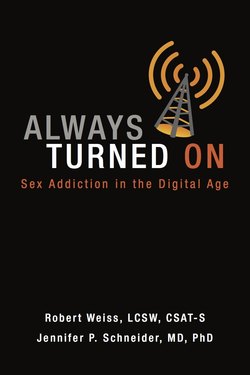Читать книгу Always Turned On - Jennifer Schneider - Страница 12
На сайте Литреса книга снята с продажи.
HOW TECHNOLOGY FEEDS SEXUAL ADDICTION
ОглавлениеThe more deeply one looks into the world of digital technology, the more obvious it becomes that anyone who is looking online for highly arousing sexual content and willing sexual partners both can and will find an unending supply. On the one hand, this is great, as the backyard dating and mating pond of yesteryear has now become a big giant ocean. On the other hand, this unlimited access can be incredibly problematic for people predisposed to addiction. In truth, digital sexual activities are a problem-free source of temporary pleasure and amusement for most people. However, those who are vulnerable to addiction can easily find themselves lost in an escalating, obsessive, online quest for “more, different, and better.”
Research conducted in the 1980s (pre-Internet) suggested that 3 to 5 percent of the U.S. adult population struggled with addictive sexual behaviors. Mostly these folks were adult men hooked on video porn, affairs, prostitution, old-fashioned phone sex, and similar activities. In that era, little to no research was then done on women. Not surprisingly, that percentage jumped significantly with the arrival of home computers and the Internet. A well-known study conducted in the late 1990s was the first to confirm this. This groundbreaking Stanford University survey looked at the behavior of more than 9,000 Internet users, finding that 8.5 percent qualified as sexually addicted.1 So basically the study found that access to the Internet approximately doubled the propensity for sexual addiction.
People in the Stanford study were considered to have a problem with addictive sex under the following circumstances:
•They described feeling “obsessed” or “driven” by online sexuality, as if it had become a “life priority.”
•They’d made repeated, unsuccessful attempts to decrease or eliminate their online sexual activities.
•They continued going online for sex despite clearly related poor academic or job performance, relationship difficulties, job loss, sexual harassment lawsuits, arrests, failed relationships, or other adverse consequences.
Interestingly, a follow-up analysis revealed that only about 1 percent of the people who qualified as sex addicts reported a pre-Internet history of compulsive sexual activity. In other words, only a few of those who were identified as sexually addicted had problems with addictive sexual behaviors before the Internet came along. For them, the Internet simply became another means of accessing their long-standing obsession. For the rest, digital technology either led to or greatly facilitated the development of their addictive sexual behavior.
More recent studies indicate this “tech facilitates sex addiction” trend reinforces itself with each new development in digital technology. And the problem is no longer limited to adult men. Thanks to digital technology, the incidence of sexual addiction is also rising among women and adolescents of both genders. There is no doubt that these changes are directly related to the easy, affordable, and mostly anonymous access to pornography, willing sexual partners, and other highly arousing sexual activities that the Internet and other forms of digital technology currently provide. In short, as digital technology has increased our access to potentially addictive sexuality, mental health professionals have seen a corresponding increase in the number and variety of people with compulsive porn use and cybersex addiction. It’s just that simple.
